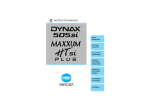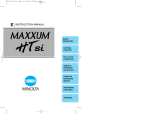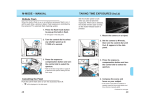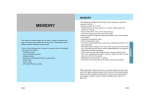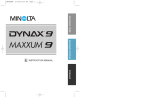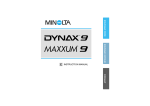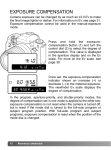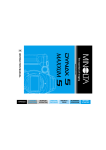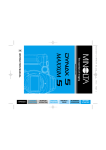Download Maxxum STsi - Jafa Photography
Transcript
E INSTRUCTION MANUAL QUICK OPERATION GETTING STARTED FULL-AUTO OPERATION SUBJECT PROGRAM SELECTION CREATIVE EXPOSURE MODES ADDITIONAL FEATURES APPENDIX FOR PROPER AND SAFE USE This manual has been designed to help you understand the operation of your Minolta camera more quickly. After familiarizing yourself with the camera, start with Level I and learn to operate the camera in Full-Auto mode. Move on to Level II and the Subject Program modes when you are comfortable with the camera and want to have more control. Here you decide the type of image you want to photograph and leave the exposure details to the camera. When you are ready for full control, move on to Level III and the ASM exposure modes. The information in this manual is relevant for products introduced before March, 1999. Contact the nearest authorized Minolta Service facility to obtain compatibility information for products released after this date. This device complies with Part 15 of the FCC Rules. Operation is subject to the following two conditions: (1) This device may not cause harmful interference, and (2) this device must accept any interference received, including interference that may cause undesired operation. Changes or modifications not approved by the party responsible for compliance could void the user's authority to operate the equipment. This equipment has been tested and found to comply with the limits for a Class B digital device, pursuant to Part 15 of the FCC Rules. These limits are designed to provide reasonable protection against harmful interference in a residential installation. This equipment generates, uses and can radiate radio frequency energy and, if not installed and used in accordance with the instructions, may cause harmful interference to radio communications. However, there is no guarantee that interference will not occur in a particular installation. If this equipment does cause harmful interference to radio or television reception, which can be determined by turning the equipment off and on, the user is encouraged to try to correct the interference by one or more of the following measures: • Reorient or relocate the receiving antenna. • Increase the separation between the equipment and the receiver. • Connect the equipment to an outlet on a circuit different from that to which the receiver is connected. • Consult the dealer or an experienced radio/TV technician for help. This Class B digital apparatus conplies with Canadian ICES-003. Read and understand all warnings and cautions before using this product. WARNING Batteries may become hot or explode due to improper use. • Use only the batteries specified in this instruction manual. • Do not install the batteries with the polarity (+/-) reversed. • Do not subject batteries to fire or high temperatures. • Do not attempt to recharge, short, or disassemble. • Do not mix batteries of different types, brands, or ages. • Tape over lithium battery contacts before disposal. Follow local regulations for battery disposal. Use caution, accidents may occur when using this product near young children. Keep batteries and other things that could be swallowed away from young children. Contact a doctor immediately if an object is swallowed. Immediately remove the batteries and discontinue use if… • the camera is dropped or subjected to an impact in which the interior is exposed. • the camera emits a strange smell, heat, or smoke. Do not disassemble. Electric shock may occur if a high voltage circuit inside the camera is touched. Take your camera to a Minolta Service Facility when repairs are required. Do not look directly at the sun through the viewfinder. CAUTION Do not allow a camera lens to point directly at the sun. Fire may occur if sunlight comes to focus on a flammable surface. Replace the lens cap when the product is not being used. 1 TABLE OF CONTENTS I L E V E L FULLY-AUTOMATIC OPERATION Taking Pictures in Full-Auto ................................................20 Focus Signals ......................................................................21 Special Focus Situations......................................................22 Focus Hold ..........................................................................23 Using the Built-in Flash Flash signals....................................................................25 Flash range......................................................................25 Fill flash ..........................................................................26 Flash cancel ....................................................................26 Red-eye reduction ..........................................................27 Rewinding the Film ..............................................................28 LEVEL II SUBJECT PROGRAM SELECTION Portrait Mode ......................................................................30 Landscape Mode ................................................................31 Close-up Mode ....................................................................32 Sports Mode ........................................................................33 Night Portrait Mode..............................................................34 Photographing Night Scenes ..............................................35 Self-timer..............................................................................36 Continuous Advance ............................................................37 2 A-MODE – Aperture Priority ................................................39 A-mode flash ..................................................................40 Aperture control ..............................................................41 S-MODE – Shutter Priority ..................................................42 S-mode flash ..................................................................43 Shutter control ................................................................44 M-MODE – Manual ..............................................................45 Metering in manual mode ................................................46 M-mode flash ..................................................................47 TAKING TIME EXPOSURES (buLb) ..................................48 III GETTING STARTED Strap ....................................................................................11 Batteries ..............................................................................12 Lens ....................................................................................14 Loading Film ........................................................................16 Handling the Camera ..........................................................18 CREATIVE EXPOSURE MODES LEVEL NAMES OF PARTS ..............................................................4 QUICK OPERATION ............................................................8 TABLE OF CONTENTS ADDITIONAL FEATURES FOCUS Manual Focus ....................51 AF Illuminator ....................52 EXPOSURE 8 Segment Metering ..........53 Spot Metering ....................54 Exposure Compensation ..55 Setting the ISO Manually ..56 Bracketing..........................57 Multiple Exposure ..............58 FLASH Slow Sync..........................61 Wireless/Remote Flash ....62 FOR OWNERS OF THE DATE MODEL Exposing the Date/Time ....67 Setting the Date/Time........68 Replacing the Battery ........69 Changing camera functions 70 APPENDIX Program Reset Button ......71 Exposure Warnings ..........75 Care and Storage ..............78 Accessories ......................72 Trouble Shooting ..............76 Specifications ....................80 3 NAMES OF PARTS NAMES OF PARTS For information on specific parts, refer to the page numbers shown in parenthesis. Body Main switch Accessory shoe Built-in flash (24-27) Flash-mode button Viewfinder* Data Panel Program-reset button (71) Subject-program button (30-35) Self-timer lamp (36) Function button Shutter-release button Film window Function dial Manual-rewind button (28) Spot /AE lock button (54) Control dial Remote-control terminal (49) Strap eyelet (11) Self-timer/Drive-mode button (36, 37) Lens contacts* Back-cover release Mirror* Focus-mode button (51) Lens mount Lens release (15) Exposure-compensation button (45, 55) * Do not touch 4 Battery-chamber door (12) Battery-chamber lock Tripod socket 5 NAMES OF PARTS NAMES OF PARTS Data Panel Viewfinder Flash-mode indicators Red-eye reduction indicator Multiple-exposure indicator Exposure-mode indicators Manual-focus indicator Shutter-speed/ISO display Aperture/Exposurecompensation display Focus frame Exposure-compensation indicator Subject-program pointer Subject-program indicators Spot-metering area Focus signals Shutter speed display Exposure-compensation indicator Aperture/Exposure-compensation display Spot/AE lock indicator Self-timer indicator Flash signal Battery-condition indicator Wireless flash indicator Drive mode indicator Cartridge mark Film transport signal Frame counter/Multiple-exposure display 6 7 QUICK OPERATION 1. Insert batteries. • This camera uses two CR2 lithium batteries. 2. Attach lens. • Align the red mounting dot on the lens with the one on the camera. Gently insert the lens into the mount and turn it clockwise until it clicks into the locked position. 3. Turn on power. • Slide the main switch to ON. QUICK OPERATION 5. Set Full-Auto operation. • Press the program-reset button to set the camera to fully-automatic operation. 6. If using a zoom lens, rotate the zooming ring to frame your subject as desired. 7. Center your subject in the focus frame, then press the shutter release button partway down. • 4. Load film. • Align the film tip with the red mark, then close the back cover. 8 The camera will focus and set exposure automatically. 8. Take the picture. • Gently press the shutter-release button all the way down to take the picture. 9 LEVEL I This section provides the information necessary to operate your camera in most photographic situations. This section covers: • Battery Installation • Attaching and Removing the Lens • Loading the Film • Camera Handling • Fully Automatic Camera Operation • Special Focus Situations • Basic Flash Operation • Rewinding the Film Once you fully understand the instructions in this section, proceed to Level II, Level III, and Additional Features to obtain more enjoyment from your camera. 10 G E T T I N G S TA R T E D Attaching the Strap BATTERIES BATTERIES Installing the Batteries Checking Battery Power Your camera uses two 3V CR2 lithium batteries to supply power for all camera operations. 1. Using a coin or similar object, turn the batterychamber lock to OPEN, then open the battery-chamber door. Each time the main switch is set to ON, a battery symbol appears in the data panel indicating the power status of the batteries. Full-battery symbol Power is sufficient for all camera operations. • will only appear for five seconds. Blinking low-battery symbol 2. Insert the batteries as indicated by the + and – marks. 3. Close the battery-chamber door, then turn the batterychamber lock to CLOSE. Power is extremely low. All functions are operational, but the batteries will need to be replaced soon. Flash recycling time may be slow. Blinking low-battery symbol appears alone and the shutter locks. Power is insufficient for camera operation. Replace the batteries. • Setting the camera down with the batterychamber door open may damage the camera. No display Power is too low for the camera to operate. Replace the batteries or make sure they have been inserted correctly. 12 13 LENS LENS Attaching the Lens Removing the Lens 1. Remove the body and rear lens caps. 1. Press the lens release and turn the lens counterclockwise until it stops. 2. Gently remove the lens and replace caps, or attach another lens. 2. Align the red mounting dots on the lens and camera body. Caution 3. Gently insert the lens into the mount, then turn it clockwise until it clicks into the locked position. • Do not force the lens if it does not turn smoothly. • Do not touch the inside of the camera, especially the lens contacts and mirror. • Do not insert the lens at an angle. • Do not press the lens release when attaching the lens. 14 15 LOADING FILM LOADING FILM Check the film window before loading film. If film is loaded, do not open the back cover. Refer to Manual Rewind on page 28 for instructions on removing a partially exposed roll. • Load film in the shade to reduce the chances of fogging the film. • Do not use Polaroid Instant 35mm film. Winding problems may occur. • If DX-coded film is used, the camera automatically sets the correct ISO (film speed). • If non DX-coded film is used, the camera will use the previous roll’s ISO setting. Refer to page 56 to set the film speed manually. • Do not use infrared film in this camera. The camera’s frame counter sensor will fog infrared film. 3. Extend the leader between the guide rails to the index mark. • If the film tip extends beyond the index mark, push the excess film back into the cartridge. 4. Close the back cover. 1. Slide the back-cover release down to open the back cover. • The camera automatically advances the film to the first frame. 1 will appear in the frame counter. • The ISO is displayed in the data panel for 5 seconds after loading. 2. Insert a film cartridge into the film chamber. • The shutter curtain’s precision design makes it extremely sensitive to pressure. Never touch it with your fingers or the film tip. 16 blinks in the frame counter and the shutter locks when the film is loaded incorrectly. Open the back cover and repeat steps 2 – 4. If film is loaded with the power off… The film’s ISO and appear in the data panel for approx. five seconds to indicate successful loading, then the camera shuts down. • If the film did not load, will blink in the data panel before the camera shuts down. Reload the film. 17 HANDLING THE CAMERA Holding the Camera Grip the camera firmly with your right hand, while supporting the lens with your left. Keep your elbows at your side and your feet shoulder-width apart to hold the camera steady. Keep the camera strap around your neck or wrist in the event you accidentally drop the camera. • Do not touch the end of the lens barrel while taking a picture. • Use a tripod when using slow shutter speeds or a telephoto lens. Pressing the Shutter-Release Button Press the shutter-release button partway down to activate the camera’s autofocus and auto-exposure systems. Gently press the shutter-release button all the way down to take the picture. 18 F U L LY - A U T O M AT I C O P E R AT I O N Full-Auto is the camera’s standard operating mode and is suited for use in almost any situation. When selected, the camera sets the focus and exposure automatically and fires the built-in flash when necessary. Use Full-Auto when you are just starting out or when you are shooting under conditions that would require you to constantly adjust the focus and/or exposure. TAKING PICTURES IN FULL-AUTO TAKING PICTURES IN FULL-AUTO 1. Slide the main switch to ON. 5. Press the shutter-release button all the way down to take the picture. • In low-light conditions, the AF illuminator (flash) will fire to determine focus distance. • Use focus hold (p23) if your subject is outside the focus frame. 2. Press the program-reset button to set the camera to Full-Auto. • The camera will return to its default settings (p71). Focus Signals The following signals appear in the viewfinder to indicate the focus status when the shutter release button is pressed partway down. 3. If using a zoom lens, rotate the lens’ zooming ring to frame the subject as desired. Focus is confirmed Continuous autofocus – Focus is confirmed 4. Center your subject in the focus frame [ ], then press the shutter-release button partway down to activate autofocus. • or will appear in the viewfinder when focus is confirmed. • The built-in flash will pop-up and fire when necessary. 20 Continuous autofocus – Lens focusing Shutter is locked Focus cannot be confirmed – Shutter is locked. Subject is too close or is one of the special focus situations described on page 22. 21 SPECIAL FOCUS SITUATIONS The camera may not be able to focus in situations like those described below. When the focus signal blinks, use focus hold (p23) or manual focus (p51). See page 21 for an explanation of the focus signals. FOCUS HOLD Use focus hold when your subject is outside the focus frame or when autofocus is difficult to confirm. If the subject within the focus frame is very bright, or low in contrast. Focus hold cannot be used for moving subjects. If two subjects at different distances overlap in the focus frame. 1. Center your subject in the focus frame, then press the shutter-release button partway down. • appears in the viewfinder when the focus is confirmed. • Focus hold also locks the exposure settings. If a subject composed of alternating light and dark lines completely fills the focus frame. If your subject is near a very bright object or area. 2. Continue to hold the shutterrelease button partway down while you compose your picture. 3. Press the shutter-release button the rest of the way down to take the picture. • Remove your finger from the shutterrelease button to cancel focus hold. 22 23 USING THE BUILT-IN FLASH In Full-Auto mode (P), the built-in flash pops-up automatically when the shutter release button is pressed partway down in lowlight situation. Once the flash is up, it will fire when necessary. USING THE BUILT-IN FLASH Flash Signals Flash is charged. • The shutter will not release until the flash is charged. • Select flash cancel ( ) when you don’t want the flash to fire. • Pressing the program-reset button (P) resets the flash to autoflash mode. Previous exposure was correct. Do not use the built-in flash with focal lengths shorter than 28mm. The built-in flash cannot cover focal lengths wider than 28mm. Flash Range The range of the built-in flash depends on the speed of the film and the selected aperture. Make sure your subject is within the flash range specified in the table below. Lens Shadowing Lens shadowing occurs when the lens or lens hood blocks part of the output from the built-in flash. Lens shadowing appears as semicircular shaded area at the bottom (horizontal) or side (vertical) of your image. • Remove the lens hood before using the built-in flash. • Lens shadowing may occur with the following lenses at shorter focal lengths. AF Zoom 28-70mm f/2.8G AF Zoom 17-35mm f/3.5G AF Zoom 20-35mm f/3.5-4.5 AF Zoom 28-135mm f/4-4.5 AF Zoom 28-85mm f/3.5-4.5 AF Zoom 35-80mm f/4-5.6 Make sure you are at least 1m (3.3 ft.) from your subject when using the built-in flash. Aperture ISO 100 ISO 200 ISO 400 f/2.8 1.0 ~ 4.3m (3.3 ~ 14.1 ft.) 1.0 ~ 6.1m (3.3 ~ 20.0 ft.) 1.0 ~ 8.6m (3.3 ~ 28.2 ft.) f/3.5 1.0 ~ 3.4m (3.3 ~ 11.2 ft.) 1.0 ~ 4.8m (3.3 ~ 15.7 ft.) 1.0 ~ 6.8m (3.3 ~ 22.3 ft.) f/4.0 1.0 ~ 3.0m (3.3 ~ 9.8 ft.) 1.0 ~ 4.2m (3.3 ~ 13.8 ft.) 1.0 ~ 6.0m (3.3 ~ 19.7 ft.) f/5.6 1.0 ~ 2.1m (3.3 ~ 6.9 ft.) 1.0 ~ 3.0m (3.3 ~ 9.8 ft.) 1.0 ~ 4.3m (3.3 ~ 14.1 ft.) • The built-in flash can not be used with the following lenses: AF 300mm f/2.8 (APO tele) AF 600mm f/4 (APO tele) 24 25 USING THE BUILT-IN FLASH USING THE BUILT-IN FLASH Fill Flash Red-Eye Reduction Use fill flash when taking pictures under fluorescent lighting or to eliminate harsh shadows. When set, the flash will fire every time a picture is taken. The TTL automatic flash metering system will ensure correct exposure. Press the flash-mode button and turn the control dial until appears in the data panel. • Make sure your subject is within the flash range specified in the table on page 25. • Press the flash-mode button and turn the control dial until appears to return to autoflash mode. • For quick shots, hold the flash-mode button down when pressing the shutter-release button to fire the fill flash. Flash Cancel Use flash cancel when photographing twilight scenes or to capture the ambiance of existing light. Press the flash-mode button and turn the control dial until appears in the data panel. • Press the flash-mode button and turn the control dial until appears to return to autoflash mode. Light reflecting from your subject’s eyes may produce the effect known as red-eye. Use the built-in flash’s red-eye-reduction mode to produce more natural looking photographs by reducing the redeye effect. 1. Turn the function dial to . 2. Press the function button and turn the control dial until and ON appear in the data panel. • Warn your subject that the flash will fire a few short flash bursts just before the picture is taken. Cancelling Red-eye Reduction Turn the function dial to , then press the function button and turn the control dial until and OFF appear in the data panel. The shutter speed may be slow. Use of a tripod is recommended. 26 27 REWINDING THE FILM Automatic Rewind After you have exposed the last frame, the camera will automatically rewind the film. When the film is completely rewound, the motor will stop and will blink in the data panel indicating it is safe to open the back of the camera. 1. Wait until the film is completely rewound. • will appear and panel. will blink in the data 2. Slide the back-cover release down to open the back cover. 3. Remove the film, then close the back cover. Manual Rewind Use manual rewind to rewind the film before the current roll is finished. 1. Press the manual-rewind button. LEVEL II Now that you are comfortable with the operation of the camera, take more control of the creative process by telling the camera what kind of picture you want to take. The subject program modes let you take more control without leaving the program exposure mode. In each of the subject program modes, the camera will automatically set the best possible shutter speed and aperture for the type of picture you are taking. This section also lets you explore the use of the Self-timer and Continuous Advance modes. Subject Program Selection Page Portrait Mode 30 Landscape Mode 31 Close-Up Mode 32 Sports Mode 33 Night Portrait Mode 34 Photographing Night Scenes 35 Drive Mode Self Timer Continuous Advance Page 36 37 Each of these functions can be explored independently after Level I has been mastered. • Press the program-reset button to return the camera to Full-Auto operation. 2. Follow steps 1-3 from Automatic Rewind. 28 SUBJECT PROGRAM SELECTION SUBJECT PROGRAM SELECTION Portrait Mode Landscape Mode Portraits have the greatest impact when a shallow depth-of-field* is used to separate the subject from the background. In Portrait mode, the necessary settings are made automatically, leaving you free to capture the perfect expression. * Depth-of-field is the area in front of and behind the point you focused on that appears sharp (p41). Landscape photography requires a large depth-of-field to make sure everything is in focus. In Landscape mode, the camera is set to obtain the greatest depthof-field possible, while maintaining a shutter speed fast enough to prevent blur due to camera shake. Press the subject-program button until the subject-program pointer is under . Tips • For best results use a mid-telephoto lens with a large aperture. • Use flash when your subject is backlit or there are strong shadows across the face (p26). • Lock focus on your subject’s eyes and be ready to capture the perfect expression. 30 Press the subject-program button until the subject-program pointer is under . Tips • For best results zoom to a wide view or use a wide angle lens and include a foreground subject or detail to create a feeling of depth in the picture. • Use flash when a subject in the foreground is backlit or has strong shadows across the face. If there is no subject in the foreground, do not use flash. • Use a tripod, especially at slower shutter speeds. 31 SUBJECT PROGRAM SELECTION SUBJECT PROGRAM SELECTION Close-Up Mode Sports Mode Set Close-Up mode when photographing small objects like flowers or jewelry. In Close-Up mode, the camera automatically sets the best possible aperture and shutter speed for the picture you are taking. Fast shutter speeds are needed to stop action. In Sports mode, the camera will set the fastest possible shutter speed and continually adjust the focus to track fastmoving subjects. Press the subject-program button until the subject-program pointer is under . Tips • For best results use a macro lens or a macro capable zoom lens. • Do not use the built-in flash if your subject is closer than 1.0m (3.3 ft.). The lens may block the flash, creating a shadow at the bottom of your image (lens shadowing). • Use a tripod to reduce camera shake. 32 Press the subject-program button until the subject-program pointer is under . Tips • The built-in flash is only effective when your subject is within the flash range. • Use fast film and keep the focus frame on your subject. • Mount the camera on a tripod when using telephoto lenses. 33 SUBJECT PROGRAM SELECTION SUBJECT PROGRAM SELECTION Night Portrait Mode Photographing Night Scenes Night portraits require the camera’s flash exposure to be balanced with the background exposure. In Night Portrait mode, the camera sets the largest possible aperture with a longer shutter speed, allowing the background to appear in the photograph. Cancel the flash in Night Portrait mode to photograph night scenes. The longer shutter speeds set in Night Portrait mode let you capture beautiful photographs of twilight scenes and night skylines. Press the subject-program button until the subject-program pointer is under . 1. Press the subject-program button until the subjectprogram pointer is under . 2. Press the flash-mode button and turn the control dial until appears in the data panel. Tips • Set the flash to or when using Night Portrait mode. See pages 26 and 27. • Use faster film and a tripod. • Focus on the main part of your subject. • Warn your subject not to move while the picture is taken. Tips • Use faster film and a tripod. • If you are photographing a dark night scene, it may be difficult for the camera to focus, use focus hold (p23) or manual focus (p51). 34 35 SELF-TIMER CONTINUOUS - ADVANCE MODE The self-timer delays the release of the shutter for approximately 10 seconds after the shutter-release button is pressed. 1. Place the camera on a tripod, then press the self-timer button until appears in the data panel. In this mode, the camera continues to release the shutter and advance the film as long as the shutter-release button is held down. • AF Zoom xi and Power zoom lenses cannot be zoomed when continuousadvance mode is selected. 1. Press the drive-mode button until appears in the data panel. 2. Center your subject in the focus frame. 3. Press the shutter-release button all the way down to start the timer. • The self-timer indicator on the front of the camera will blink, then glow just before the shutter releases. • Self-timer mode is cancelled after the shutter is released. • Do not press the shutter-release button while standing in front of the camera. • Attach the eyepiece cap if there is a bright light source behind the camera (p49). 2. Press the shutter-release button down and hold. • When taking flash pictures, the shutter will release after the flash is charged. • When the subject is moving, the shutter will release after the camera focuses on the subject. • To return to single frame mode, press the drive mode button until appears in the data panel. Press the self-timer button or slide the main switch to LOCK to cancel the self-timer before the shutter releases. 36 37 A-MODE – APERTURE PRIORITY In A-mode, you select the aperture and the camera automatically sets the shutter speed required for proper exposure. Set the camera to A-mode when you want to control the range of sharpness (depthof-field) in an image. Refer to Aperture Control on page 41. 1. Turn the function dial to LEVEL III . In this section you take full creative control of your camera. Depending on the selected exposure mode, you will control the aperture, shutter speed, or both to capture your image. In the previous sections, only the Program (P) exposure mode has been explored. Here you will learn to use the Aperture Priority (A), Shutter Priority (S), and Manual (M) exposure modes. Select A-mode to control the depth-of-field in your images. Set S-mode to control the way moving subjects appear in your images. Set M-mode when you want full control over all the exposure functions. Exposure Mode A-Mode Manually select aperture S-Mode Manually select shutter speed M-Mode Manually select the shutter speed and the aperture Page 39 42 45 2. Press the function button and turn the control dial until A appears in the data panel. 3. Turn the control dial to select the aperture. • Each exposure mode can be explored independently. If 2000 or 30 s blinks in the data panel, the required setting is beyond the camera’s shutter speed range. Turn the control dial until the blinking stops. 39 A-MODE – APERTURE PRIORITY A-MODE – APERTURE PRIORITY A-Mode Flash Aperture Control When the built-in flash is up or an attached accessory flash is on, it will fire each time a picture is taken. The camera’s TTL automatic flash metering system will ensure proper exposure. Press the flash-mode button to pop-up the built-in flash. • will appear in the data panel. • The shutter speed is automatically set to 1/90 or slower. • A smaller aperture (larger f-number) will result in a shorter flash range. Refer to Flash Range (p25) to determine the range of the built-in flash at the selected aperture. If 90 blinks in the viewfinder and the data panel, the light level is too bright for the selected aperture. Turn the control dial until the blinking stops or cancel the flash. Cancelling the Flash Push the built-in flash down or turn the accessory flash off. • will be displayed in the data panel. 40 Large Aperture (small f-number) Small Aperture (large f-number) The size of the aperture (lens opening) determines the depth-of-field in the final image as well as the intensity of the light falling on the film. Depth-of-field is the range in front of and behind the focus point that appears sharp in the final image. In the viewfinder, only the plane the camera is focused on will appear sharp. The photographed image however, will have a depth-of-field corresponding to the selected aperture. Large apertures (small numbers) limit the depth-of-field to a narrow range in front of and behind the point of focus. Set a larger aperture when photographing portraits to make your subject stand out from the background. Small apertures (large numbers) provide greater depth-of-field. Set a small aperture when photographing landscapes to ensure your entire scene is sharp. • Usable apertures will depend on the aperture range of the lens you are using. 41 S-MODE – SHUTTER PRIORITY S-MODE – SHUTTER PRIORITY In S-mode, you select the shutter speed and the camera automatically sets the aperture required for proper exposure. Use S-mode when you want to control the blur caused by subject movement. 1. Turn the function dial to S-Mode Flash When the built-in flash is up or an attached accessory flash is on, it will fire each time a picture is taken. Flash exposure is controlled by the camera’s TTL automatic flash metering system. . 1. Press the flash-mode button to pop-up the built-in flash. • will appear in the data panel. 2. Turn the control dial to select any shutter speed up to 1/90th of a second. 2. Press the function button and turn the control dial until S appears in the data panel. • The camera automatically sets the aperture for the selected shutter speed. Cancelling the Flash 3. Turn the control dial to select the shutter speed. Push the built-in flash down or turn the accessory flash off. • will be displayed in the data panel. • The number 60, or 125, displayed in the data panel stands for 1/60th or 1/125th of a second. • The seconds indicator appears in the viewfinder and data panel if the shutter speed is one second or longer. If the aperture display in the data panel blinks, the required setting is outside the aperture range of the lens. Turn the control dial until the blinking stops. 42 43 S-MODE – SHUTTER PRIORITY M-MODE – MANUAL M-mode gives you full control of the exposure. The camera’s meter index displays how your settings compare to the exposure determined by the camera’s metering system. Shutter Control 1. Turn the function dial to . 2. Press the function button and turn the control dial until M appears in the data panel. Fast Shutter Speed Slow Shutter Speed In addition to controlling the duration of the exposure, shutter speed determines how moving subjects will appear in the final image. Depending on the speed of your subject, slow shutter speeds will make a moving subject appear to flow, creating a feeling of motion. In addition to stopping action, fast shutter speeds can help prevent blur caused by camera movement during exposure, known as camera shake. 3. Turn the control dial to select the shutter speed. • Use a fast shutter speed to stop the motion of your subject. • Use a slow shutter speed to blur the motion of your subject. 4. Press the exposurecompensation button and turn the control dial to select the aperture. 44 45 M-MODE – MANUAL M-MODE – MANUAL Metering in Manual Mode M-Mode Flash In manual mode, the meter index in the viewfinder and the data panel indicates how your exposure compares with the camera’s meter reading. When the built-in flash is up or an attached accessory flash is on, it will fire each time a picture is taken. Flash exposure is controlled by the camera’s TTL automatic flash metering system. 1. Press the flash-mode button to pop-up the built-in flash. – The exposure will overexpose your subject. • will appear in the data panel. 2. Turn the control dial to select any shutter speed up to 1/90th of a second. – The exposure will underexpose your subject. 3. Press the exposurecompensation button and turn the control dial to select the aperture. If an exposure compensation indicator does not appear, your settings agree with the exposure determined by the camera. • Refer to the flash range table on page 25 to determine the aperture setting and the flash range. Cancelling the Flash Push the built-in flash down or turn the accessory flash off. • 46 will be displayed in the data panel. 47 TAKING TIME EXPOSURES (buLb) Set the shutter speed to bulb when you want to take time exposures. When bulb is selected, the shutter remains open as long as the shutter-release button is pressed. 1. Mount the camera on a tripod. 2. Set the camera to M-mode, then turn the control dial until appears in the data panel. TAKING TIME EXPOSURES (buLb) 5. Firmly press the eyepiece cap into the eyepiece. • The eyepiece cap prevents light from entering thru the viewfinder and affecting the metered exposure. 6. Press and hold the shutterrelease button to take the picture. • The shutter remains open as long as the button is pressed. Attaching the Remote Cord To reduce image blur, attach either the Remote Cord RC-1000S or RC-1000L (sold separately). 3. Press the exposurecompensation button and turn the control dial to select the aperture. 1. Flip the remote-controlterminal cover up. 2. Insert the plug into the terminal. 4. Compose the scene and focus on your subject. • If the scene is too dark for autofocus to operate, press the focus-mode button and focus the lens manually (p51). 48 49 FOCUS – Manual Focus Focus the lens manually when autofocus is not suitable and focus hold is not possible. The autofocus system will monitor focus and indicate when a subject in the focus frame is in focus. 1. Press the focus-mode button. will appear in the data panel. ADDITIONAL F E AT U R E S 2. Turn the focusing ring until your subject appears sharp and focused. • appears in the viewfinder when the subject in the focus frame is in focus. • Press the focus-mode button again to return to the autofocus mode. AF Power Zoom and xi-Series Lenses Pull and turn the control ring until your subject appears sharp. 51 FOCUS – AF Illuminator The AF Illuminator is a secondary function of the built-in flash. When the scene is too dark for the camera to focus accurately, the built-in flash fires a few short bursts when the shutterrelease button is pressed partway down to provide the illumination necessary for the camera to focus on your subject. EXPOSURE – 8 Segment Metering Eight-Segment Honeycomb-Pattern Metering is the camera’s standard metering mode and is appropriate for most photographic situations. • The range of the AF Illuminator flash is approximately one to five meters. • The AF illuminator will not fire in continuous focus mode or if flash cancel ( ) is selected. • The AF illuminator will not operate with 300mm or longer single focal length lenses. • The AF illuminator will not operate with 3x-1x Macro Zoom. • When an accessory flash is attached, its AF illuminator will be active in place of the camera’s AF illuminator. • Changing Camera Functions (p70) lets you cancel the built in flash’s AF illuminator if it will interfere with your subject or is inappropriate. 52 53 EXPOSURE – Spot Metering Use only the center metering segment to lock the exposure settings without locking the focus. The exposure remains locked until the spot/AE lock button is released. • Pressing the spot/AE lock button sets the flash to slow sync mode (p61). EXPOSURE – Exposure Compensation The metering system in this camera averages the readings from each active metering segment to determine an exposure that will achieve an average middle grey tone on the film. Compensated Exposure 1. Place the spot-metering area on the subject whose exposure you want to lock. Dark scenes are often overexposed. Exposure compensation lets you adjust the metered exposure +/– 3 stops in 1/2 stop increments. Metered Exposure 2. Press and hold the spot/AE lock button. • and the locked exposure will be displayed in the viewfinder. 3. Recompose the scene as desired, then press the shutter-release button all the way down to take the picture. • The exposure is held until the spot/AE lock button is released. • Changing camera functions (p70) lets you change the operation of the spot/AE lock button to... Press to activate/Press again to cancel 54 This effect is most visible when slide film is being used. Press the exposurecompensation button and turn the control dial until the desired compensation value appears in the data panel. • Exposure compensation remains until it is reset or cancelled. • To cancel exposure-compensation, repeat the above procedure and select 0.0 or press the program-reset button. • Exposure compensation is not available in M-mode. 55 EXPOSURE – Setting the ISO Manually EXPOSURE – Bracketing Set the film speed manually when you want to override the DX-coded film speed or when using non-DX-coded film. Film speeds can be set from ISO 6 to 6400 in 1/3EV increments. Film must be loaded before the ISO can be changed. 1. Turn the function dial to ISO. Metered Exposure 1/2 Stop Under 1/2 Stop Over This function automatically exposes a 3 frame 1/2 stop increment bracketed series. The order of the exposures will be the metered exposure, 1/2-stop under the metered exposure, 1/2 stop over the metered exposure. • The automatic bracketing feature cannot bracket flash exposures. 2. Press the function button and turn the control dial until the desired ISO value appears in the data panel. This effect is most visible when slide film is being used. While pressing the exposurecompensation button, press the shutter release button all the way down and hold. • The camera automatically exposes a three frame bracketed series. • Releasing either button before the series is complete cancels the exposure series. 56 57 EXPOSURE – Multiple Exposure EXPOSURE – Multiple Exposure The multiple-exposure function makes it possible to expose two or more images on the same frame. 4. Press the shutter-release button all the way down again to take the last exposure. • Multiple-exposure mode is cancelled after the last exposure has been taken. Metering Multiple Exposures 1. Turn the function dial to . The meter in your camera determines exposure (EV) based on the assumption that only one exposure will be made on each frame. When making multiple exposures, the EV for each additional exposure needs to be reduced or over exposure will result. • Compensation is not necessary if all of the exposures have dark backgrounds and the subjects of the exposures will not overlap. 2. Press the function button and turn the control dial until appears in the data panel. • appears in the frame counter. 3. Compose the scene, then press the shutter-release button all the way down to take the first exposure. Compensate the exposures as follows: Number of Exposures Exposure Adjustment • The above corrections are intended as a general guideline. Some testing may be necessary to produce the desired results. • Exposure can be compensated in 1/2 EV increments using the exposure compensation function (p55) and in 1/3 EV increments by changing the ISO manually (p56). blinks in the data panel, indicating the next exposure will be the last in the series. • To take more than 2 exposures, repeat steps 1 and 2 until ME glows in the data panel. 58 59 EXPOSURE – Multiple Exposure FLASH – Slow Sync In P and A-modes, slow-shutter sync sets a slower shutter speed to increase the background or ambient lighting exposure in a flash picture. Flash output will automatically be decreased to maintain a correct exposure of your subject. Cancelling Multiple Exposure 1. Turn the function dial to . 2. Press the function button and turn the control dial until OFF appears in the data panel. Slow-shutter Sync Conventional Flash Sliding the main switch to LOCK does not cancel multiple exposure mode. 1. Frame your subject. 2. While pressing the spot/AE lock button, press the shutterrelease button all the way down to take the picture. • If the background is bright or a large aperture is set (A-mode), the shutter speed may not be reduced. • Use a tripod if the shutter speed becomes too slow to allow sharp, hand-held pictures after you press the spot/AE lock button. • and the locked exposure will be displayed in the viewfinder. 60 61 FLASH – Wireless/Remote Flash Normal Flash Wireless/Remote Flash Wireless/Remote Ratio Flash Wireless/Remote Flash is available with the Minolta 5400HS, 5400xi, and 3500xi accessory flashes. Wireless/Remote flash lets you experience the creative control available with an accessory flash. In Wireless/Remote flash mode, the off-camera flash is triggered by a coded signal from the camera’s built-in flash when you press the shutter-release button. When proper exposure has been received, another signal cuts the accessory flash off. You can also achieve a 2:1 lighting ratio automatically. When remote ratio flash is selected, the off-camera flash provides 2/3 of the full exposure while the built-in flash provides the remaining 1/3. FLASH – Wireless/Remote Flash Setting Wireless/Remote Flash Mode 1. Attach the accessory flash to the camera, then turn the camera and the flash on. 2. Turn the function dial to WL. 3. Press the function button and turn the control dial until WL and On appear in the camera’s data panel. 4. Detach the accessory flash, then press the camera’s flash mode button to raise the builtin flash. Continued on next page. 62 63 FLASH – Wireless/Remote Flash Taking Pictures in Wireless/Remote Flash Mode The off-camera flash will provide all of the exposure. 1. Position your camera and 3500xi flash unit using the information on this page. FLASH – Wireless/Remote Flash 2. Wait until both flash units are fully charged. • appears in the viewfinder when the builtin flash is charged. • When the off-camera flash is charged, its AF illuminator will blink. • If you are not using the 3500xi flash, refer to your flash instruction manual for the correct camera to subject and flash to subject distances. Press the spot/AE lock button to test fire the accessory flash. 3. Press the shutter-release button all the way down to take the picture. Wireless/Remote Ratio Flash Aperture Camera – Subject Distance 3500xi – Subject Distance f/2.8 1.4 – 5.0m (4.6 – 16 ft.) 1.0 – 5.0m (3.3 – 16 ft.) f/4.0 1.0 – 5.0m (3.3 – 16 ft.) 0.7 – 4.5m (2.3 – 14.5 ft.) f/5.6 1.0 – 5.0m (3.3 – 16 ft.) 0.5 – 3.2m (2.3 – 10.5 ft.) Press the flash-mode button when taking the picture. Both flashes will fire when the shutter is release at a 2:1 ratio. The built-in flash will provide 1/3 and the accessory flash will provide 2/3 of the total exposure. • Calculated for ISO 100 film only. 64 65 FLASH – Wireless/Remote Flash Cancelling Wireless/Remote Flash Mode 1. Attach the accessory flash to the camera, then turn the flash on. FOR OWNERS OF THE QUARTZ DATE MODEL The Quartz-data function lets you record the date or time onto the lower-right corner of the photograph. The quartz data back has an automatic calendar through the year 2019. • Imprinted data may be difficult to read if the lower-right corner of the photograph is bright or non-uniform. • Imprinting size and position may differ according to printing conditions. • Do not use the data back when temperatures exceed the operating range of 0 to 50 °C (32 to 122 °F). 2. Turn the function dial to WL. Print indicator Select button Mode button 3. Press the function button and turn the control dial until WL and OFF appear in the camera’s data panel. Adjust button Exposing the Date/Time Before taking the picture… 1. Press the mode button to choose the data imprinting format. • The display changes as follows: 4. Detach the accessory flash. 2. Take the picture. • If the print indicator blinks after the shutter is released, the data was exposed. 66 67 FOR OWNERS OF THE QUARTZ DATE MODEL FOR OWNERS OF THE QUARTZ DATE MODEL Setting the Date/Time Replacing the Battery 1. Press the mode button to choose the data imprinting format. The quartz data back uses a CR2025 lithium battery, located on the inside of the back cover. Replace the battery if the display or imprinted data becomes dim. • M will appear above the month. 1. Open the back cover. 2. Use the select button (SEL) to move between different parts of the displayed data. 2. Using a coin or similar object, turn the battery cover counter-clockwise, then remove it. • The selected part will blink, indicating that it is the data to be changed. 3. Press the adjust button (ADJ) to change the data to the correct value. • Data continues changing as long as the button is held down. • In time mode, pressing the ADJUST button while : is blinking resets the seconds counter to zero (not shown). 3. Remove the old battery and replace it with a new one. • The + side should face up. 4. Replace the battery cover, then reset the date and time. 4. When all data is correct, press the select button (SEL) until the data stops blinking. 68 69 CHANGING CAMERA FUNCTIONS Spot/AE Lock Button Operation Slide the Main switch to LOCK, then to ON while pressing the Program-reset button and Spot/AE lock button. • Repeat the above procedure to return to the previous setting. Press to activate, release to cancel. APPENDIX Program Reset Button Press once to activate, press again to cancel. Press the program-reset button to return the following camera functions to their program settings. FUNCTION AF Illuminator (Built-in Flash) Function Exposure mode Slide the Main switch to LOCK, then to ON while pressing the Flash-mode button. • The status of the AF illuminator is displayed in the data panel. P mode Focus mode Autofocus Flash mode Auto-on Exposure Compensation Film-drive mode +/– 0 Single-frame advance Self-timer Cancelled AF IIluminator On Wireless/Remote Flash Cancelled When the built-in flash is up, its AF illuminator fires when necessary to assist focus. Bracketing Cancelled Multiple Exposure Cancelled • The AF illuminator does not fire when flash cancel ( selected. ) is AF Illuminator Cancelled The built-in flash’s AF illuminator will not fire. • An attached accessory flash’s AF illuminator will not be cancelled. • Other flash functions will operate normally. 70 P-MODE SETTING • Date, red-eye reduction, ISO settings will not change. • Pressing the program-reset button will also reset an attached dedicated accessory flash’s program settings. Refer to the flash instruction manual for details. • Spot/AE lock button function, AF illuminator function will not change. ACCESSORY INFORMATION This camera is designed to work specifically with lenses and accessories manufactured and distributed by Minolta. Using incompatible accessories with this camera may result in unsatisfactory performance or damage the camera and accessories. Compatibility of Accessories Lenses • All Minolta AF lenses can be used with this camera. • MD and MC series lenses (manual focus) cannot be used with this camera. ACCESSORY INFORMATION Accessory Flash Control When using an accessory flash, the desired flash mode can be selected using the camera or the flash. CAMERA Press the flash-mode button and turn the control dial to select the desired flash mode. • The camera transfers data to the accessory flash immediately. Flashes • All Minolta i, si, and HS series flash units, and the Vectis SF-1 flash, are compatible with this camera. (Hi-speed syncro mode on HS flash cannot be used with this camera.) • The Flash Shoe Adapter FS-1100 is required to mount AF series flash units (4000AF, 2800AF, 1800AF, and Macro flash 1200AF). • When the FS-1100 is used… - The flash will fire every time the shutter is released. - The AF illuminator will not activate. - The built-in flash is set to fill flash when the accessory flash is removed. • X-series flashes and flashes sold by other manufacturers cannot be used with this camera. FLASH Press the flash’s ON/OFF button to select the desired flash mode. • Data is not transferred from the flash until the shutter-release button is pressed partway down. • Fill flash cannot be selected when the camera is set to Full-Auto or any of the Subject Program modes. Others • The following accessories are not compatible with this camera: Control Grip CG-1000 Data Receiver DR-1000 Creative Expansion Cards Anglefinder Magnifier Wireless Controller IR-1N 72 73 ACCESSORY INFORMATION For owners of the optional lens kits EXPOSURE WARNINGS Indicators will blink in the viewfinder or data panel when there is a problem with the exposure. Lens Hood Flare is non-image forming light that degrades image quality. A lens hood improves image quality by reducing flare. • Remove a lens hood before using the camera’s built-in flash. Fit the lens hood into the mount at the end of the lens barrel, then turn the hood clockwise until it stops. MODE CAUSE P A S M Scene or subject brightness is beyond the camera’s metering range. P Light level is beyond the range of available shutter speeds and apertures. A The required shutter speed is beyond the range of the camera. S The required aperture is beyond the range of the lens. • To store the hood, reverse it, attach it to the lens, then replace the lens cap. 74 DISPLAY ACTION Bright Light: use slower speed film, a neutral density (ND) filter, or reduce the light level of your surroundings. Low Light: use higher speed film or a flash. Select a larger or smaller aperture until the display stops blinking. Select a faster or slower shutter speed until the display stops blinking. 75 TROUBLE SHOOTING TROUBLE SHOOTING Contact your nearest Minolta Service Facility if the following information does not cover the problem which you are experiencing or the condition continues. PROBLEM CAUSE SOLUTION PAGE Batteries are loaded incorrectly. Remove and reinstall the batteries. 12 Batteries are exhausted. If the camera battery is exhausted, install a new battery. 12 Situation is unsuitable for autofocus. Use focus hold or manual focus. Camera is set to manual focus mode. Press the focus mode button to return the camera to autofocus mode. Subject is too close. Check the minimum focus distance for your lens. Focus cannot be confirmed. Use focus hold or manual focus. Camera is attached to a microscope or telescope. Contact a Minolta service facility for information. – Flash fires when the shutter-release button is pressed partway down. The AF illuminator is on. This is a normal camera operation. – Flash picture is too dark. Subject is beyond flash range. Make sure the subject is within the flash range. 25 Lower part of flash picture is dark. Lens hood attached. Remove lens hood. 74 Camera Malfunction Remove and reinstall the batteries. If normal camera operation does not resume or the camera malfunctions repeatedly, contact an authorized Minolta Service Facility. 12 No display appears when the camera is switched on. Autofocus does not work when shutterrelease button is pressed partway down. Shutter cannot be released. Err appears in the data panel. 76 23/51 51 – 23/51 77 CARE AND STORAGE CARE AND STORAGE Operating Temperature and Conditions Cleaning • This camera is designed for use from -20 to 50 °C (4 to 122 °F). • Never leave your camera where it may be subjected to extreme temperatures such as the glove compartment of a car. • Data panel response time will be slow at colder temperatures. The display will temporarily darken at higher temperatures, but will restore when the temperature normalizes. • Never subject the camera to extreme humidity. • To prevent condensation from forming, place the camera in a sealed plastic bag when bringing it from cold environment to a warm environment. Allow it to come to room temperature before removing it from the bag. • The low-battery symbol may appear even with fresh batteries depending on the storage conditions. To restore camera power, repeat turning the camera on and off. • Battery capacity decreases at colder temperatures. Keep your camera and spare batteries in a warm inside pocket when shooting in cold weather. Batteries will regain some of their capacity when warmed to normal operating temperature. Storage When storing your camera for extended periods, • Always attach the protective caps. • Store in a cool, dry, and well-ventilated area away from dust and chemicals such as moth balls. For long periods, place the camera in an airtight container with a silica gel drying agent. • Periodically release the camera’s shutter to keep it operating properly. • Before using after prolonged storage, check the camera’s operation to make sure it is functioning properly. 78 • If the camera or lens barrel is dirty, wipe it gently with a soft, clean, dry cloth. If the camera or lens comes in contact with sand, gently blow away loose particles - wiping may scratch the surface. • To clean the lens surface, first brush away any dust or sand then, if necessary, moisten a lens tissue with lens cleaning fluid and gently wipe the lens in a circular motion, starting from the center. • Never place lens fluid directly on the lens. • Never touch the interior of the camera, especially the shutter and mirror, doing so may impair their alignment and movement. • Dust on the mirror will not affect the exposure but may affect the focus, Use a blower brush to remove dust from or around the mirror. • Never use compressed air to clean the camera’s interior, it may cause damage to sensitive interior parts. • Never use organic solvents to clean the camera. • Never touch the lens surface with your fingers. Before Important Events • Check the camera’s operation carefully, or take test photographs. • Minolta is not responsible for any loss that may occur due to an equipment malfunction. Questions and Service • If you have questions about your camera, contact your local camera dealer or write to the Minolta distributor in your area. • Before shipping your camera for repair, please contact an authorized Minolta Service Facility for details. 79 SPECIFICATIONS Camera Type: Lens Mount: Viewfinder: Shutter Type: Speeds: Flash sync speed: Focus Type: 35mm SLR with built-in flash, autoexposure (AE), and action predictive autofocus (AF) Minolta A-type bayonet mount SLR roof mirror type, 90% field of view, Magnification: 0.75X Drive Modes: Rewind: Frame counter: Electronically-controlled, vertical-traverse, focal-plane type 30 sec. - 1/2000 sec., bulb 1/90 or slower TTL phase-detection system, with one CCD sensor. Autofocus and manual focus modes. AF Sensitivity Range: EV -1 to18 (ISO 100) AF Illuminator: Built-in with range of 1.0 - 5.0m. Automatically activated in low-light/ lowcontrast situations. AF Control: Single-shot, continuous, automatic AF-mode selection. Exposure Modes: P, A, S, M, and 5 Subject Program modes (Portrait, Landscape, Close-up, Sports, Night Portrait) Type: TTL metering; direct TTL metering for flash Metering Cell: 8-segment honeycomb pattern SPC for ambient light and flash-metering SPC for flash. Metering Range: Multi-segment metering: EV 1 - 20, Spot metering: EV 4 - 20 (ISO 100, f/1.4 lens) Film-speed Setting: Automatic: ISO 25 to 5000 for DX-coded film. Manual: ISO 6 to 6400 in 1/3 EV increments. Flash: ISO 25 - 1000. Film Transport Loading: Auto load 80 SPECIFICATIONS Built-in Flash GN: Coverage: Recycling Time: Single frame, continuous advance (1 frame/sec.), self-timer, exposure bracketing, and multiple exposure. Auto rewind, manual start (Count-down display) Forward (shows number of exposures taken) 12 (ISO 100 in meters) 28mm angle of view Approx. 3 sec. (according to Minolta test methods) Additional Power: Two CR2 lithium batteries Battery Performance: Condition A Flash Use (%) 0 50 100 20 °C 40 rolls 17 rolls 11 rolls -10 °C 30 rolls 13 rolls 8 rolls Condition B 20 °C 65 rolls 23 rolls 14 rolls -10 °C 50 rolls 18 rolls 10 rolls * 24 exposure rolls Condition A: Lens(35-80 f/4-5.6) focused from infinity to 2m three times and the shutter-release button held partway down for ten seconds before each exposure. Condition B: Lens(35-80 f/4-5.6) focused from infinity to 2m and the shutter-release button held partway down for five seconds before each exposure. • Battery performance will vary with usage conditions. • Exposures taken at a rate of 2 rolls/month. Dimensions : Weight : 135.0 x 90.0 x 58.5mm (WxHxD) QD model: 135.0 x 90.0 x 61.0mm (WxHxD) 350g (w/o camera battery), QD model: 360g (w/o camera battery) Specifications and accessories are based on the latest information available at the time of printing and are subject to change without notice. 81 NOTES 82 NOTES 83 NOTES NOTES This mark certifies that this product meets the requirements of the EU (European Union) concerning interference causing equipment regulations. CE stands for Conformité Européenne (European Conformity). 84 85 Minolta Co., Ltd. 3-13, 2-Chome, Azuchi-Machi, Chuo-Ku, Osaka 541-8556, Japan Minolta GmbH Minolta France S.A. Minolta (UK) Limited Minolta Austria Ges. m.b.H. Minolta Camera Benelux B.V. Belgium Branch Minolta (Schweiz) AG Minolta Svenska AB Finland Branch Minolta Portugal Limitada Minolta Corporation Head Office Los Angeles Branch Minolta Canada Inc. Head Office Vancouver Branch Minolta Hong Kong Limited Minolta Singapore (Pte) Ltd. Shanghai Minolta Optical Products Co., Ltd. Kurt-Fischer-Strasse 50, D-22923 Ahrensburg, Germany 365 Route de Saint-Germain, F-78420 Carrieres-Sur-Seine, France 7 Tanners Drive, Blakelands, Milton Keynes, MK14 5BU, England Amalienstrasse 59-61, A-1131 Wien, Austria Zonnebaan 39, P.O. Box 6000, NL-3600 HA Maarssen, The Netherlands Prins Boundewijnlaan 1, B-2550 Kontich, Belgium Riedstrasse 6, CH-8953 Dietikon, Switzerland Albygatan 114, S-171 54 Solna, Sweden Niittykatu 6 PL 37, SF-02201 Espoo, Finland Av. do Brasil 33-A, P-1700 Lisboa, Portugal 101 Williams Drive, Ramsey, New Jersey 07446, U.S.A. 11150 Hope Street Cypress, CA 90630, U.S.A. 369 Britannia Road East, Mississauga, Ontario L4Z 2H5, Canada 230-3771 Jacombs Road, Richmond, B.C. V6V 2L9, Canada Room 208, 2/F, Eastern Center, 1065 King’s Road, Quarry Bay, Hong Kong 10, Teban Gardens Crescent, Singapore 608923 368 Minolta Road, Songjiang, Shanghai, China © 1999 Minolta Co., Ltd. under the Berne Convention and Universal Copyright Convention Printed in Malaysia 9222-2155-11 MM-B909














































